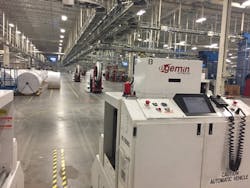Most of us are well acquainted with the Valpak coupons we receive in the mail each month. But do you realize how much advanced automation technology goes into producing those familiar mailers? When you open the next Valpak mailer you receive, think about this: You are likely the first human to touch those coupons.
Valpak’s $200 million, 470,000-square-foot printing and distribution facility in St. Petersburg, Florida—where all of its coupon mailers are produced—is quite possibly the most automated facility I have ever visited. During a plant tour offered by Siemens as part of its annual Automation Summit event, I got an up close look at the technology housed in the facility. Siemens technologies play key roles in the center’s press and collation rooms.
See a video highlighting the automation at Valpak in action.
The press room houses two Goss presses (each about the size of a football field) running 24/7, five days a week. These presses, moving at speeds up to 2,100 feet per minute, produce Valpak’s four color coupons at a rate of 100,000 impressions per hour. Capable of printing single and two-panel coupon inserts simultaneously, the presses require no manual press checks. According to Dave Smith, Valpak’s plant director, “checks are done digitally in the plant’s quality lab where every step of the manufacturing process is monitored.”
Siemens programmable logic controllers (PLCs), drives and human-machine interfaces (HMIs) are used to automate the presses’ operation. Each press has approximately 25 Siemens Master Control Drives and several Siemens Micro Master Drives along with five Siemens S7-400 PLCs and two S7-300 PLCs, and numerous Siemens ET200S and ET200M I/O modules. Siemens' WinCC supervisory control and data acquisition (SCADA) server provides the press data Valpak uses to improve operations, including estimated/actual setup times, average speed for the job, paper waste, and downtime for make ready and maintenance.
The collation process starts after receipt of a print reel delivered to the collators via automated guided vehicles that navigate through the facility via a wireless network. Ten collators operate in the facility. Each collator continuously handles cutting, stacking, packaging, addressing and traying of the printed coupons. Valpak’s collation system is run via the integration of five Siemens S7-400 PLCs integrated with a WinCC SCADA server to manage 25 web clients used for process visualization and system control. Each PLC controls one mail tray system (where the envelopes are placed in USPS delivery format) and two collators.
This array of five Siemens PLCs replaced 40 PC-based controllers used previously for collator control. “Not only do we have a longer life span with Siemens PLCs—10 to 15 years versus 5 years with PC-based control—we were able to improve process and systems efficiency since all collator and mail tray control functionality is integrated with Siemens hardware and software,” Smith said. Mail tray control was formerly part of a PLC/SCADA platform designed for Valpak by multiple vendors and OEMs.
Smith noted that using the integrated Siemens technology on the collators allows Valpak to “create unlimited system capabilities for current and future business growth, handle rewinder roll doctoring of wrap defects, allow for selective demographic inserts, and offer unique address piece match—where an inserted piece is identified with a barcode and connected to a mailing address,” said Smith.
Leaders relevant to this article:


